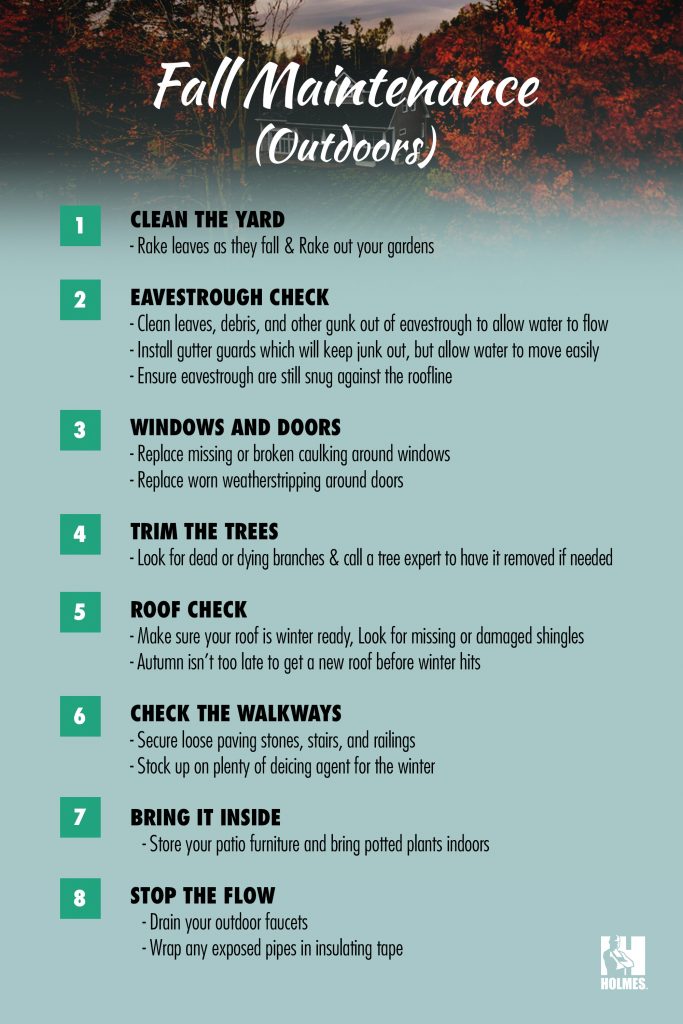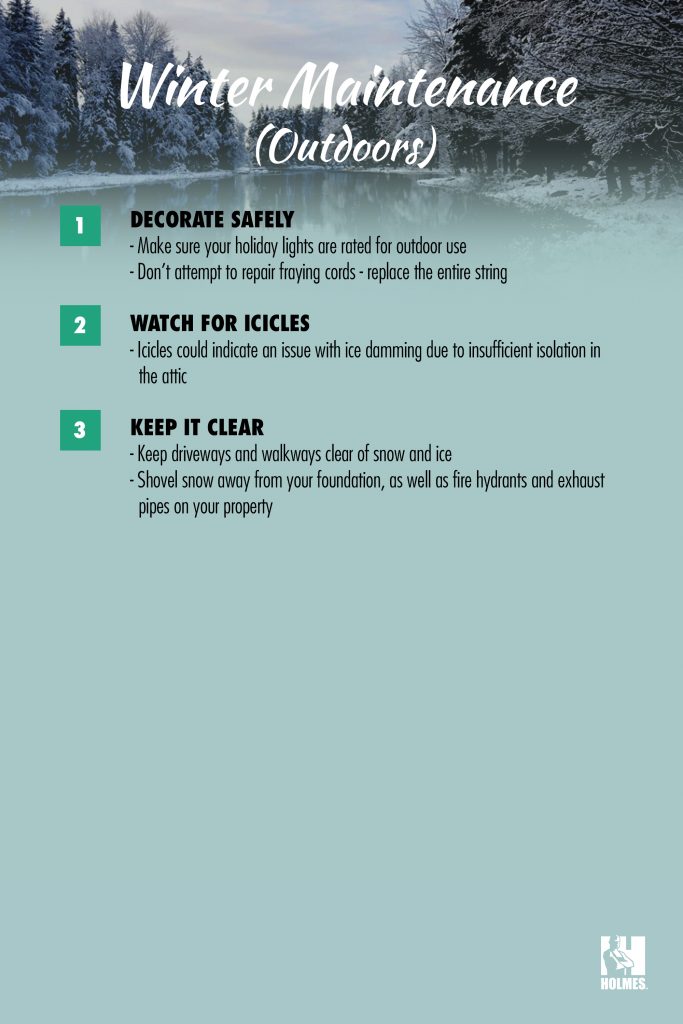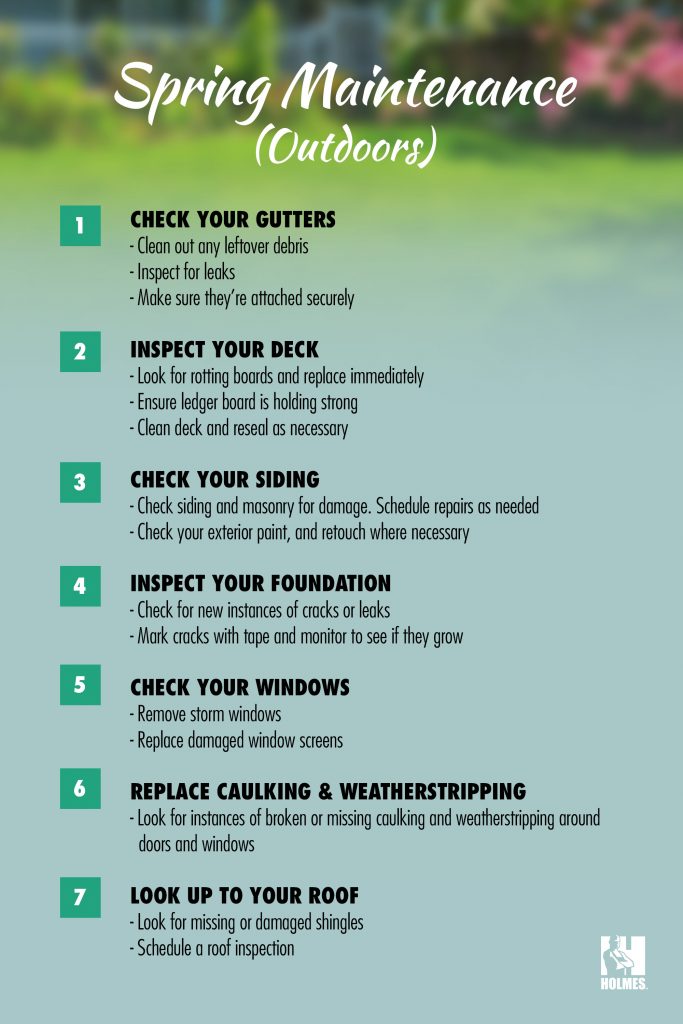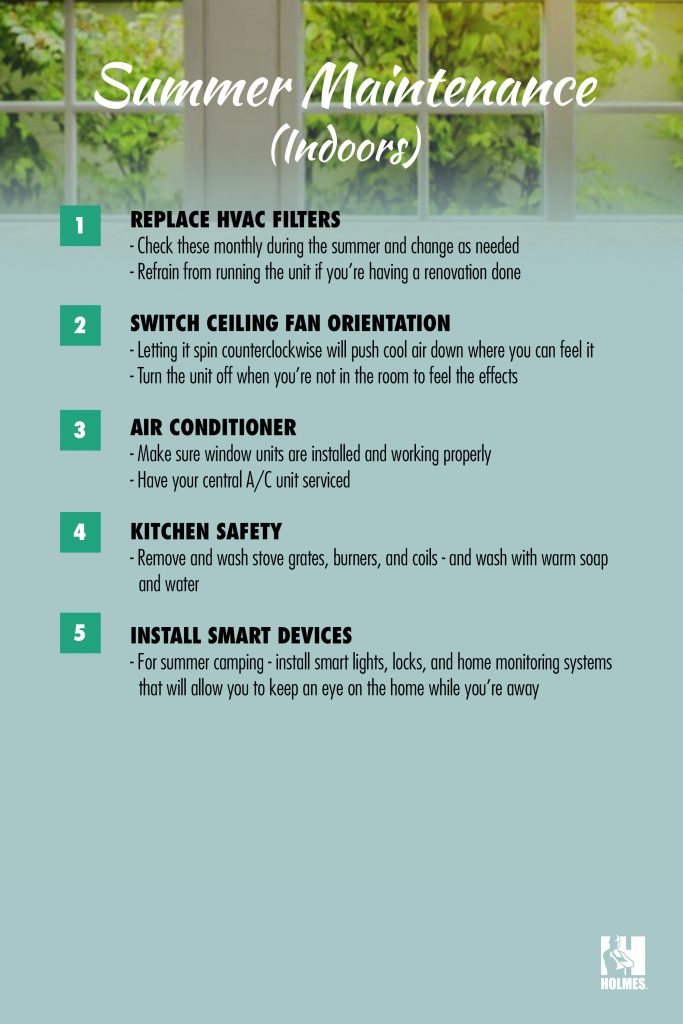Choosing the right siding for your home isn’t just about looks. I’ve said it a million times: PROTECT YOUR HOME FROM THE OUTSIDE IN. Siding is also about protection,...
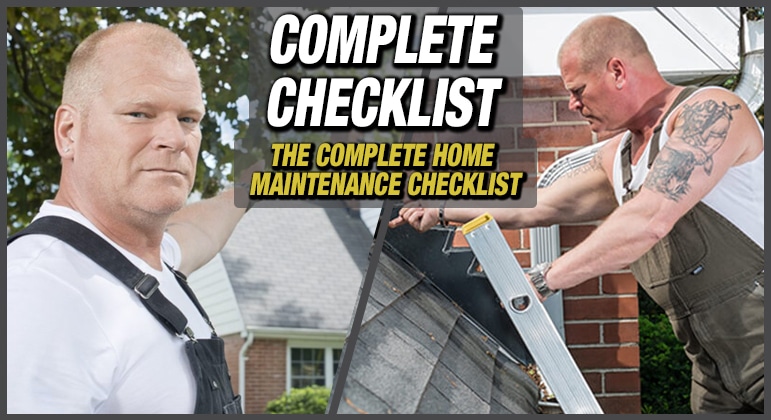
THE COMPLETE HOME MAINTENANCE CHECKLIST
By Mike Holmes
Mike’s Advice / Home Safety & Maintenance
Tuesday, April 6th, 2021 @ 2:57pm
Neglecting small home maintenance tasks will cause you grief in the long run. This is the ultimate home maintenance checklist to follow:
Check for Water Leaks
A leak in your home means wasted water, and that’s how you end up with a high water bill. Check for:
- Leaking or running toilets
- Dripping faucets
- Leaks under the sink
- Old or leaky hot water heater
- Leaky washing machine and dishwasher
Locating your home’s main water supply (also called the main shut off valve) is crucial information any homeowner should know in case there’s ever a leak or a burst pipe—it could save you thousands of dollars in water damage.
RELATED:
Why Is Your Water Bill So High?
How To Remove A Musty Smell From Your House
IS YOUR SUMP PUMP IN GOOD SHAPE?
Your sump pump had a big job to do: it needs to remove excess below grade water away from your foundation. These units don’t last forever, and you might not think about them until you notice there’s an issue with it. Having it inspected in the spring is a good idea – just to ensure it’s in working order.
Having your sump pump connected to a backup source of power like a generator is a good idea in case you have a prolonged power outage.
TEST TEST TEST
Test your smoke alarms, carbon monoxide detectors, fire extinguishers, and all ground-fault circuit interrupters. Smoke alarms and carbon monoxide detectors should be tested monthly
Check for these Electrical Fire Warning Signs
- Flickering/dimming lights and light bulbs
- Breakers that always trip
- Fuses that always blow
- Faulty extension cords
- Appliances that have a burning smell when they’re on, including the lights in a room
- Discolored wall outlets
- Electrical outlets that spark
- Faulty electrical appliances
- Outlets and light switches that are hot when you touch them
- A wall is abnormally hot
- Loose plug retention in outlets – Do your cords stay plugged in?

They’re all signs that tell you something may be wrong with the electrical system in your home.
RELATED:
CHANGE YOUR FURNACE FILTERS
I recommend changing your filter every 90 days at minimum, and monthly in the winter. If the air filter is dirty, your indoor air is dirty. It’s a good habit to change them monthly – at least in the summer and winter.
CHECK FOR MOLD
If you only see a bit of mold but feel sick, you might have a bigger problem than you think. Your best bet is to call a pro and don’t attempt your own clean-up.
Check these key areas in the home where mold tends to grow-the basement, bathrooms, walls, ceiling corners, the attic, crawlspaces and on windowsills. If you live somewhere humid, the garage can also be place for mold to thrive.
Any mold that covers more than 10 sq/ft needs to be tackled by a mold abatement specialist.
RELATED:
INSPECT YOUR GUTTERS

Your gutters can be a source for moisture intrusion if they’re not properly cleared.
If your eavestroughs clog often with leaves and debris, consider installing a screen over top to keep water moving clearly through your system.
CHECK KITCHEN AND BATHROOM VENTILATION
Making sure your bathroom and kitchen ventilation systems are working is important for your indoor air quality. This is especially important in newer homes that are built to be more airtight.
Have you tried the tissue test? Hold up a tissue to your bathroom exhaust fan to see if it’s pulling in the tissue.
Learn more about ventilation in your kitchen and bathroom here.
CHECK YOUR FOUNDATION FOR CRACKS
You want to make sure your home’s #1 enemy (water) is not entering your home through foundation cracks. Not all cracks are immediate cause for concern. Mark them with tape and keep a close eye on them. If the crack continues to expand, or you can squeeze a dime in the foundation crack, it’s time to bring in a specialist.
CHECK YOUR WINDOWS
If you notice your windows starting to fog and form condensation, there could be a number of reasons. It may be an excess of humidity, faulty windows or poor ventilation. You need to investigate this because weeping windows can lead to mold and can compromise the structure of the window.
You can buy a hygrometer to check the humidity levels throughout your home. If the humidity levels are high in different areas of your home, you can buy a portable dehumidifier. Or call an HVAC professional to install a furnace integrated dehumidifier. Your home should have a humidity level between 40 and 60%
CHECK FOR PEST INTRUSION
It doesn’t take much for critters to get into your home. A mouse can fit through a hole as small as ¼ of an inch. Make sure to seal and gaps or holes around pipes doorways and windows to keep them out. You may also want to install some mesh screening over exhaust pipes.
Your chimney should be securely capped to keep larger critters from sneaking in from up top.
If you hear scratching behind the walls, are finding small pieces of stool around the home, or bagged items in your pantry have mysterious holes, call in a pest pro.
CHECK FOR AIR LEAKS
- Take a look at your roof after a snow fall. If there are patches of melted snow or lots of icicles forming around the roofline, that’s a sign that warm air is leaking into the attic from the living space, making your home more difficult to heat.
- Check the weather stripping around your doors and windows. If it is broken or missing, you’re allowing unwanted drafts to creep into your home and your dollar bills are flying out the window.
- Check your electrical outlets, baseboards, air conditioners and switch plates for cracks and gaps that could cause air leaks
RELATED:
LOOK UP AT YOUR ROOF
Look out for these red flags as you glance up at your roof:
- Bare Spots.
- Buckling in the middle of the shingle or curling at the edges.
- Large accumulations of granules in the eavestroughs.
- Torn or missing shingles.
Although you will be able to spot some of these red flags, it’s important to have your roof professionally inspected.

I don’t recommend you go up there and do it yourself – the pros are trained to work at heights – you might not be.
RELATED:
TEST YOUR INDOOR AIR QUALITY
Did you know that the air inside you home can be 2-5x more polluted than the outdoors? This is why indoor air quality needs to be on the top of your mind when thinking about your home.
From volatile organic compounds (VOCs), radon, mold, formaldehyde, and more, there is a lot to think about when considering a healthy indoor air quality in your home. It can have a significant impact on your health.
RELATED:
INSPECT YOUR DECK
Inspect your deck for loose screws and protruding nails, corroding fasteners and rotting wooden boards to help you determine whether or not your deck needs repairs.
One of the more frequent issues is loose nails, as well as loose or wobbly connections. They can lead to serious structural issues and if not fixed, can cause injuries.

If your deck looks like it’s in questionable condition, schedule a deck inspection through a reputable home inspection company
HERE’S A TIP: When it rains, watch where the water is draining off your deck. All water should drain towards the front of your deck, not back towards your home.
READ MORE:
INVESTIGATE GARAGE DOOR PROBLEMS
The garage door is typically the largest moving item on a house. It also serves as the most common point of entry, think of how many times a day you walk under the garage door, and think of how important it is that the door is properly installed and running safely.
Here are some common issues to investigate:
- Is your garage door noisy?
- Is there water at the bottom of your garage door?
- Does your garage door refuse to close?
RELATED:
HOME MAINTENANCE CHECKLISTS FOR EVERY SEASON
Seasonal Home Improvement: Fall Maintenance Checklist
Your main job as a homeowner during the fall season is to make sure your home is prepared to face the onslaught that the winter months bring.
- Replace caulking and weatherstripping around doors and windows
- Look for any missing or loose shingles as they may allow water and snow to creep into your attic space.
- Take a survey of the landscaping around your home and make sure you have the proper grading. Water management around the home is key to protecting your home over winter.
- If you think you have a leaky basement, get it fixed now! This is very important, as this is your last chance. Another winter season of a freeze and thaw cycle could make it worse.
If your windows or doors need replacing you want to do that now too. It will help you save money over winter, so you’re not cranking up the furnace.
RELATED:
Seasonal Home Improvement: Winter Maintenance Checklist
Test every smoke alarm monthly. Replace the batteries when the clocks change. During the holidays we like to use candles more frequently and tend to cook a lot more. This is why you should inspect every smoke detector in your house to make sure it is in proper condition and replacing the batteries if needed. The same goes for carbon monoxide detectors.
If you have any cracks in your walkway, they can become a tripping hazard – especially as the freeze-thaw cycle can cause those cracks to expand and heave. You can make repairs yourself using Sikadur Crack Fix.
Pipes that go below insulation or through cold zones, such as crawlspaces, the garage or along an exterior wall (not insulated) must be wrapped. This helps prevent frozen pipes or a burst pipe which might not present itself until the spring thaw brings you a flooded basement.
READ NEXT:
Seasonal Home Improvement: Spring Maintenance Checklist
As a homeowner, the first thing you want to do during the spring is to walk around your home and take note of the areas that were damaged by the winter season. If any of your major structures are in need of repair, there’s your first job during spring home improvement season.
If you think you need a new roof, don’t wait. Start making the calls to your roofer now. Their schedules will fill up quickly, and you don’t want to wait too long to replace a failing roof system.
- Inspect caulking around windows
- Check attic for leaks, mold, moisture intrusion, fire hazards & critters
- Remove debris and gunk from the top and exterior parts of your outdoor air conditioning units. It’s likely that over the winter, trash, foliage and debris has found its way around the unit.
READ NEXT:
Seasonal Home Improvement: Summer Maintenance Checklist
Summertime is when most insects make their way indoors looking for cooler places to make their homes. Check the exterior of your home for these possible entry points for pests:
- Holes or cracks around window and door frames
- Holes in venting
- Tears in window and door screens
- Cracks in foundations, especially below windows and doorsteps. If the crack in your foundation is smaller than a dime, use an injection repair kit like SikaFix®
Torn window screens should be repaired or replaced. If you have any visible gaps in your mortar or loose bricks (also known as tuck-pointing) get them refilled and seek a professional, as this is a special skill that needs to be done properly.
READ NEXT:
OPENING YOUR COTTAGE CHECKLIST
Most cottage owners have the unpleasant surprise of having unwanted intruders in their summer home. You’ll want to be on the lookout for obvious signs of unwanted entry — things like holes in your soffits, torn window screens.
Animals can even pull away siding and find their way through your roof venting or your chimney.
Even something as small as a mouse can cause big issues. These small rodents can eat away at wood in your home or chew through electrical wires.
Here’s a full guide for opening up your cottage.
READ NEXT:

